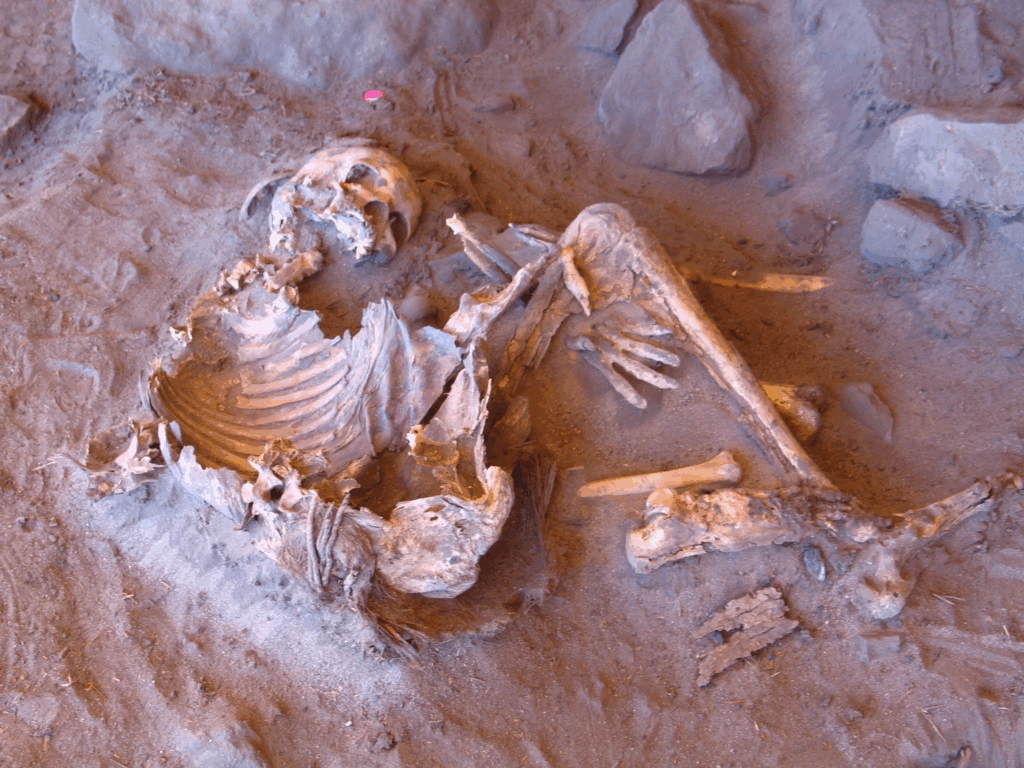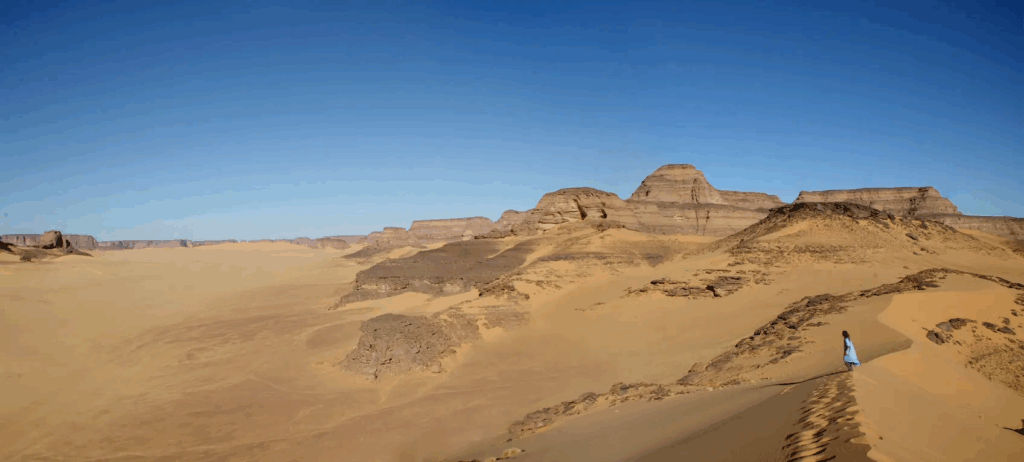The Hidden Ancestors: Sahara Mummies Rewrite the Story of Humanity

Hidden deep within the parched heart of the Sahara, a discovery has emerged that forces humanity to question its very beginnings. In a rock shelter in southwestern Libya, scientists unearthed two naturally preserved mummies dating back nearly seven thousand years. These ancient individuals carry DNA unlike any seen in modern humans, revealing a forgotten lineage that split off long before known populations began to spread across the globe. The find not only rewrites the history of early humans in Africa but also sheds light on the extraordinary diversity of our ancient ancestors.
Further studies of the surrounding landscape have revealed evidence of once abundant flora and fauna, painting a vivid picture of what life was like during the Green Sahara period. Fossilized remains of fish and river plants suggest that the area was once rich in freshwater resources that sustained thriving communities. These discoveries help scientists better understand how early humans adapted to environmental transformations that would later shape their destiny.
Moreover, the conditions that allowed these mummies to survive for millennia continue to fascinate researchers. The extreme dryness of the desert, combined with natural shelter from wind and sunlight, created a rare environment that halted decay. This unique preservation provides modern scientists with a priceless time capsule, capturing not just human remains but also traces of daily life and the surrounding ecosystem.

Image Credit: Archaeological Mission in the Sahara, Sapienza University of Rome
Echoes of the Green Sahara
Long before the Sahara became an endless desert, it was a vibrant land teeming with lakes, grasslands, and life. Around 14,000 to 5000 years ago, seasonal rains transformed the region into fertile savannas that supported thriving human and animal populations. This period, known as the Green Sahara, offered a sanctuary to communities who hunted, gathered, and later herded livestock across its lush plains. The Takarkori rock shelter, where the mummies were found, was once a home and burial site for these ancient people, who lived in harmony with the changing landscape.
Archaeologists had excavated the Takarkori site for years before realizing the extraordinary genetic secrets hidden within its remains. When researchers extracted DNA from the two mummified women, they expected to find links to known African or Eurasian groups. Instead, what they discovered shocked them: the DNA bore no relation to any population alive today. These women belonged to a completely unknown human lineage, one that had diverged from the main genetic branches of humanity tens of thousands of years earlier.
The revelation paints a picture of ancient Africa as a continent divided not by geography alone but by invisible genetic boundaries. While other populations migrated and mixed freely, the Takarkori people seem to have lived in isolation, preserving a unique genetic identity that vanished when the climate changed.
The Genetic Enigma of Takarkori
The DNA results from the Takarkori mummies left scientists both amazed and puzzled. Their genomes lacked the hallmarks of modern North Africans, sub-Saharan Africans, and even the Neanderthal traces common in people of non-African descent. The finding suggests that this lineage represents a branch of humanity that evolved separately, possibly cut off by the Sahara’s expanding deserts and fluctuating climate patterns.
Researchers estimate that this genetic split occurred roughly 50,000 years ago, around the same time early humans began migrating out of Africa. However, unlike those who traveled into Europe and Asia, the ancestors of the Takarkori people appear to have remained in the Green Sahara, adapting to its fertile landscape until environmental shifts forced them to disappear. As the rains faded and the region dried, the desert reclaimed their world, leaving behind only fragments of bone and traces of DNA to tell their story.
This discovery has transformed scientific understanding of ancient migrations. For years, anthropologists believed that during the African Humid Period, people moved freely across the continent, spreading both genes and culture. The Takarkori findings reveal a more complex reality: rather than a seamless web of interaction, Africa’s ancient populations were a mosaic of isolated groups, each evolving along distinct genetic paths.
Layers of Lost Humanity
The Sahara has long been seen as an empty void between civilizations, but this discovery redefines it as a cradle of forgotten peoples. The Takarkori women represent not just individuals but entire communities that thrived in conditions now unimaginable. Their existence challenges the idea that Africa’s human story followed a simple, linear path. Instead, it was a tapestry woven from countless threads of migration, adaptation, and extinction.
These findings echo discoveries elsewhere on the continent that hint at similar patterns of genetic isolation. Ancient remains in Ethiopia, Morocco, and southern Africa have revealed distinct human groups that flourished independently before blending into larger populations. The Sahara’s newly uncovered lineage fits into this broader picture, showing that early humanity was far more diverse and regionally varied than previously thought.
Such revelations highlight how much of Africa’s prehistory remains hidden beneath the surface. Vast stretches of desert, forest, and savanna have yet to be explored using modern genetic techniques. Each discovery brings us closer to understanding how many unique branches of the human tree have been lost to time.

Image Credit: Archaeological Mission in the Sahara, Sapienza University of Rome
Culture in Isolation
Beyond the DNA, archaeologists have uncovered artifacts at Takarkori that reveal a sophisticated culture. Stone tools, pottery fragments, and evidence of early animal domestication suggest that the people who lived here were innovators in their own right. They developed technologies and social practices independently from other known groups, demonstrating that human ingenuity flourished even in isolation.
These ancient North Africans likely engaged in small-scale herding and foraging, living close to rivers and wetlands that sustained their communities. The preservation of their mummified remains hints that burial rituals held spiritual significance. Though their words and traditions are long gone, the care taken in their burials reflects a deep sense of identity and reverence for the afterlife.
The Takarkori discoveries suggest that the spread of farming, herding, and cultural innovation across ancient Africa may not have required vast migrations. Ideas could have traveled through exchange and observation rather than large-scale movement of people, showing how knowledge connects even those separated by great distances.
The Climate Shift That Erased a People
As millennia passed, the Sahara’s climate began to change. Rains dwindled, lakes evaporated, and the once-green plains turned to dust. The people of Takarkori, who had adapted so successfully to the lush environment, faced the slow collapse of their world. Archaeological evidence suggests that some may have migrated southward or toward the Nile Valley, while others perished as resources vanished.
This environmental transformation serves as a powerful reminder of the fragility of human existence. The Takarkori people, once thriving amid abundance, became victims of forces beyond their control. Their disappearance mirrors other collapses in human history, where climate and ecology dictated the fate of entire civilizations.
In many ways, their story resonates with modern challenges. As global temperatures rise and ecosystems shift, we too face questions of adaptation and survival. The past, frozen in the Sahara’s sands, offers lessons for the present about resilience and the impermanence of all human achievements.

Image Credit: Archaeological Mission in the Sahara, Sapienza University of Rome
The Power of Modern Science
The ability to recover and analyze DNA from such ancient remains marks a triumph of modern science. Only in recent years have techniques advanced enough to extract usable genetic material from mummified tissue exposed to harsh desert conditions. Researchers from multiple countries collaborated to piece together this remarkable discovery, combining archaeology, genetics, and climate science to build a fuller picture of the Sahara’s forgotten inhabitants.
These advancements are opening new frontiers in understanding human evolution. By comparing ancient genomes from across Africa, scientists can now map previously invisible connections between populations, track migrations, and even reconstruct vanished cultures. Each fragment of DNA acts as a time capsule, preserving evidence of people whose existence was long erased by sand and time.

The research teams are now developing innovative tools to analyze even smaller fragments of ancient DNA, enabling them to recover genetic information from remains once considered impossible to study. These technological leaps not only enhance our understanding of human ancestry but also allow us to explore how ancient people interacted with their environments, diseases, and each other. This ongoing progress reminds us that science is an ever-evolving dialogue with the past, constantly revealing new perspectives on what it means to be human.
Reflections on a Forgotten Past
The story of the Takarkori mummies is one of rediscovery and humility. It invites us to see the Sahara not as an empty wasteland but as a repository of untold stories. Each ancient site that emerges from the sands reveals not only who our ancestors were but also how much of their world we have yet to comprehend.
As researchers continue to search for more remains across North Africa, they hope to fill in the missing chapters of humanity’s origin story. With every bone, artifact, and strand of DNA, we gain a clearer view of the incredible diversity that shaped our species.
In the end, the Takarkori mummies remind us that entire human worlds can vanish without a trace, surviving only in fragments that later generations stumble upon. Their discovery underscores how incomplete our understanding of the past still is, and how many human stories remain hidden beneath shifting sands and forgotten landscapes. With each new piece of evidence, we come closer to seeing the true complexity of our origins, one in which every lost lineage, no matter how distant, adds depth and meaning to the shared human journey.
Featured Image Credit: Courtesy of Nicolas Jehly | Unsplash
Loading...

